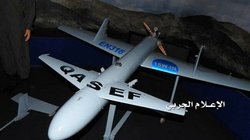 Yemen’s Houthi Ansarullah movement has considerably upgraded the precision of its armed drones, the Wall Street Journal said in a new report, describing the group as the world’s “most proficient” in using unmanned aerial vehicles.
Yemen’s Houthi Ansarullah movement has considerably upgraded the precision of its armed drones, the Wall Street Journal said in a new report, describing the group as the world’s “most proficient” in using unmanned aerial vehicles. RNA - The Houthis “have launched armed drone attacks with far more precision and reach than the US and its [Persian] Gulf allies have publicly acknowledged,” it quoted people familiar with the matter as saying in its report.
According to the Journal, the Houthis have become one of the most adept groups in the world at using drones in war.
Its technology has evolved from small, propeller-powered surveillance drones to a larger plane-shaped model that can travel more than 900 miles at a speed of 150 mph, covering much of the Persian Gulf, including the Saudi and Emirati capitals, it said.
“We’ve been told at the Wall Street Journal that Houthis began with fairly rudimentary propeller-driven drones that can do damage, but first they are primarily used for surveillance and reconnaissance, not for attack,” WSJ reporter Warren P. Strobel said.
“As time went on, the Houthis became more proficient, and were able to actually conduct attacks, armed attacks, using drones,” he added.
The report pointed to Ansarullah’s attacks on Saudi Arabia’s Aramco refinery and an airport in Abu Dhabi in 2018 as the first drone attacks of the group.
“Soon after the Aramco attack on July 26, 2018, the Houthis claimed that they had attacked Abu Dhabi Airport, hundreds of miles from Yemen. And it did damage a truck and disrupted the flights for a short period of time,” WSJ reporter Dion Nissenbaum said.
“Of course the Houthis claimed the attack, and there were celebrations in the streets. The government of the Emirates denied there had been a successful drone attack. We were told by current and former officials that the US sort of went along with the story,” Strobel said.
"The reason for the cover story was that there was this concern that had it gone publicly known that there was a successful attack, even though the damage was somewhat marginal, it could have had widespread economic ramifications for UAE and other countries in the [Persian] Gulf region," he added.
According to Strobel, several sources later told the Wall Street Journal that “despite the denial at the time, this attack did indeed happen.”
The WSJ report also highlighted a Yemeni drone attack on an air base in the country’s southwestern province of Lahij in January 2019, during which General Saleh Zindani, deputy army chief of staff of former Yemeni president, sustained severe injuries and later succumbed to the wounds.
The report described the attack as the world’s first known assassination of a foreign government official using a drone.
“They are probably the most proficient group around the world, outside of governments, in using drones,” Strobel said.
The spokesman for Yemeni Armed Forces had earlier this year said army troopers and allied fighters from Popular Committees have a large number of domestically-developed combat drones and ballistic missiles in their inventory, and 2019 will be the “year of Yemeni combat drones.”
He said Yemeni forces have manufactured several state-of-the-art combat drones and ballistic missiles, which will be put on display in the near future.
Missile attack on Saudi aggressors
The Yemeni army on Thursday night targeted a gathering of Saudi mercenaries in southwest of the kingdom with four missiles.
According to Yemen’s Al-Masirah, the Zelzal-1 Yemeni-made missiles hit the Saudi forces in al-Raboah near Asir region.
The report did not mention the number of casualties caused by the attack.
Saudi Arabia invaded Yemen in 2015 with the aim of reinstating former president Abd Rabbuh Mansour Hadi who resigned amid a political deadlock in January 2015 and then fled to Riyadh.
According to new figures from the United Nations, the Saudi war in Yemen will have claimed about 102,000 lives by the end of 2019, indicating that the invasion has killed far more people than previously reported.
A number of Western countries, the US and Britain in particular, are accused of being complicit in the ongoing aggression as they supply the Riyadh regime with advanced weapons and military equipment as well as logistical and intelligence assistance.
847/940